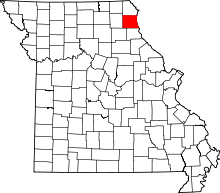Quincy, Illinois micropolitan area
|
| |
| Largest city Other cities |
Quincy |
| Population | Quincy is Ranked 156th in the U.S. |
| - Total | 116,378 |
| - Density | ???/sq. mi. ???/km² |
| Area | ??? sq. mi. ??? km² |
| State(s) | Illinois, Missouri |
| Elevation | |
| - Highest point | ??? feet (??? m) |
| - Lowest point | ??? feet (??? m) |
The Quincy-Hannibal, IL-MO Combined Statistical Area, as defined by the United States Census Bureau, is an area consisting of one county in western Illinois and Three counties in northeast Missouri, anchored by the city of Quincy and Hannibal.
As of the 2010 census, the μSA had a population of 116,378.[1]
Counties
In Illinois
In Missouri
Communities
All populations are based on the 2012 population estimates.
Anchor Cities
Places with 1,000 to 5,000 inhabitants
- Vandalia (partial) Pop: 4,017
- Palmyra Pop: 3,610
- Monroe City (partial) Pop: 2,485
- Canton Pop: 2,376
- Camp Point Pop: 1,129
- Payson Pop: 1,020
Places with 500 to 1,000 inhabitants
- New London Pop: 981
- Mendon Pop: 948
- La Grange Pop: 931
- Clayton Pop: 704
- Perry Pop: 702
- La Belle Pop: 656
- Golden Pop: 641
- Ursa Pop: 626
- Lewistown Pop: 530
- Liberty Pop: 516
- Center Pop: 512
Places with less than 500 inhabitants
- Ewing Pop: 452
- Loraine Pop: 313
- Plainville Pop: 264
- Rennselaer Pop: 231
- Lima Pop: 163
- Coatsburg Pop: 147
- Columbus Pop: 99
- Monticello Pop: 98
- La Prairie Pop: 47
Unincorporated places
- Beverly
- Bigneck also spelled Big Neck
- Burton
- Durham
- Fall Creek
- Fowler
- Hickory Grove
- Kellerville
- Kingston
- Marblehead
- Marcelline
- Maywood
- Meyer
- North Quincy
- Paloma
- Philadelphia
- Richfield
- Steffenville
- Taylor
- West Quincy
- Williamstown
Demographics
As of the census[2] of 2000, there were 78,771 people, 30,816 households, and 20,705 families residing within the μSA. The racial makeup of the μSA was 95.21% White, 3.00% African American, 0.16% Native American, 0.37% Asian, 0.01% Pacific Islander, 0.33% from other races, and 0.92% from two or more races. Hispanic or Latino of any race were 0.82% of the population.
The median income for a household in the μSA was $32,718, and the median income for a family was $39,937. Males had a median income of $29,475 versus $20,381 for females. The per capita income for the μSA was $16,320.
In 2015 Quincy, Illinois was named as a finalist for the All-American City. [3]
Education
Quincy, IL is home to institutions of higher education including Vatterott College,[4] John Wood Community College,[5] and Quincy University.[6]
See also
References
- ↑ "Table 1. Annual Estimates of the Population of Metropolitan and Micropolitan Statistical Areas: April 1, 2000 to July 1, 2009 (CBSA-EST2009-01)" (CSV). 2009 Population Estimates. United States Census Bureau, Population Division. 2010-03-23. Retrieved 2010-03-26.
- ↑ "American FactFinder". United States Census Bureau. Retrieved 2008-01-31.
- ↑ http://www.ci.quincy.il.us/news/2015/04/01/quincy-named-a-finalist-for-2015-all-american-city-award
- ↑ "Vatterott College - Quincy, IL". Retrieved April 2015.
- ↑ "About John Wood Community College". Retrieved April 2015.
- ↑ "Quincy University". Retrieved April 2015.
External links
- Census (dead link)
| |||||||||||||||||||||||||||||
| |||||||||||||||||||||
| ||||||||||||||||||||||||||||||
Coordinates: 39°56′N 91°23′W / 39.933°N 91.383°W
